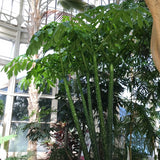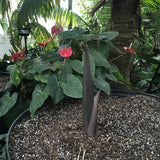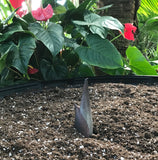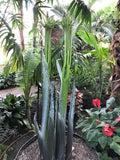Fester & Morticia the Corpse Flowers
TWO Corpse Flowers are GROWING!
October 2019
Both Corpse Flowers are a Leaf Structures!
August 2019
In early July 2014, the Botanical Gardens acquired three Amorphophallus titanum corms, Morty, Fester and Morticia. Since then, Morty has produced one leaf structure and two flowers. Fester has produced one leaf and one flower and Morticia has produced one leaf.
Amorphophallus titanum, commonly known as corpse flowers, are native to the rainforests of Sumatra, Indonesia and are famous for their horrible smell, like rotting flesh, while in bloom. Corpse flowers typically bloom every 6-10 years, making it a rare sight to see and smell. When the plant blooms, the flower and stench will only last 36-48 hours.
In between blooming, the plants go through a cycle of dormancy and create a large, compound tree-like leaf. Over time, the old leaf dies and a new one grows in it’s place. The leaf structures collect energy so the plant can bloom again in the future. Unfortunately, the leaf structure has no offensive smell.
When the first growth appears, it can be hard to predict if the plant will become a leaf or flower. At this stage it can grow several inches per day and will produce a leaf or flower within several weeks of its first growth. In the early stages of growth, a flower can look wider at the bottom and a leaf can appear uniformly shaped. Fester showed signs of growth about four weeks ago and its five leaf structures are currently two to four feet tall. Fester has produced five leaf structures which is unusual for this plant. The leaf structures can grow up to 20 feet tall and 16 feet across. Leaf structures will last many months to over a year until the corm has gathered enough energy. The leaf structure then dies off and it will go dormant for a few months. This process repeats until it has enough stored energy for a bloom.
Morticia showed signs of growth about two weeks ago and is growing at a much slower rate. Because Morticia’s coloring and growth shape is different, the horticulture team at the Botanical Gardens believes it will be a flower. It is hard to predict when and if Morticia will be in full bloom. If Morticia is a flower, our best estimate would be that Morticia would be in full bloom within six to eight weeks.
Facebook
Twitter
Instagram
Morty’s Twitter - @Mortystinks
Use hashtag #CorpseFlower when posting!
The Facts:
Our Plants
- Like many corpse flowers living at botanical gardens, ours have names. Meet our friends Fester & Morticia!
- Fester and Morticia came to our Botanical Gardens with one other corpse flower corm (Morty) in early July of 2014.
- Fester has made one leaf and one flower and Morticia has produced one leaf since being adopted by the Botanical Gardens.
- When the first growth appears, it can be hard to predict if the plant will become a leaf or flower. At this stage it can grow several inches per day and will produce a leaf or flower within several weeks of its first growth. In the early stages of growth, a flower can look wider at the bottom and a leaf can appear uniformly shaped. Fester is growing five leaf structures and Morticia is still unpredictable. Because Morticia’s coloring and growth shape is different, the horticulture team at the Botanical Gardens believes it will be a flower.
- When they are not blooming they send up enormous leaf structures to collect energy to bloom again in the future. Unfortunately, the leaf structure has no offensive smell.
- They will both be on display inside the Main Palm Dome. If Morticia is indeed a flower, she will be moved into greenhouse 2 so visitors can view the plant on all sides.
- Updates will be available on the Botanical Gardens’ website, Facebook page - Buffalo and Erie County Botanical Gardens, Twitter and Instagram accounts - @buffalogardens and through Morty’s Twitter Account @MortyStinks. Like and follow to keep up to date with Fester’s progress. Use hashtag #CorpseFlower when posting!
Fester’s Leaf Structures
- The leaf can grow very tall up to 16 feet across and to 20 feet tall. Because Fester has five leaf structures, the horticulture team believes the leaf structures will be smaller than the usual one leaf structure.
- In between blooming, the plants go through a cycle of dormancy and creating a large, compound tree-like leaf. The leaf structure will last many months until the corm has gathered enough energy. Over time, the old leaf dies, then goes dormant and a new one grows in it’s place. This process repeats until it has enough energy for a bloom. The speckles and dots on the leaf’s stem help act as camouflage so animals won’t bother the plant.
- If you look at the unfurled leaf, you’ll notice it has three ‘branches’. These are the leaflets on this large, compound leaf. Other plants that have compound leaves include ferns, ash trees and walnut trees.
- The leaf comes from the part of the plant called a corm. A corm is an underground tuber, a swollen plant stem that is a storage organ for plants. A corm is similar to a true bulb. This large structure looks like a big potato.
- Picky about growing conditions, these plants need water every day. They love high heat, humidity and misty conditions preferring to be in 50/50 shade and light.
Morticia’s Possible Flower
The Stench and Pollination
- It is hard to predict when the inflorescence will be in full bloom. Our best estimate would be in early-mid September.
- This plant gets its common name from the awful smell it produces - it really smells like rotting meat.
- When it finally blooms, the flower (and its accompanying stench) lasts only a short while- on average 24-48 hours.
- The stench attracts flies and beetles as pollinators. This stinky attraction is similar to the carrion flower and voodoo lily, more smelly plants in the Botanical Gardens’ collection.
- The stench is strongest in the evening and the plant actually increases its temperature to mimic that of rotting meat - better luck attracting (and tricking!) pollinators this way. The heat also helps spread the smell farther distances.
- The smell comes from the female flowers. The female flowers open first, along with the opening of the outer leaf, the spathe. The shape of the spathe helps to amplify the smell, funnel the pollinators down further into the plant where the flowers are, and protect the flowers.
- Male flowers open second with pollen grains. They do not flower at the same time as the females in order to prevent self-pollination. Ideally, another corpse flower would be in bloom nearby at a different point in the bloom cycle. The confused flies would walk among multiple plants, looking for the carrion they smell and unknowingly pollinate the plant.
- It is common practice for botanical gardens to cut a hole in the spathe later on in the bloom cycle to harvest pollen. This does not harm the plant, as the flowers are inside protected by the spathe.
- Pollination can occur by hand with pollen grains saved from past blooms. We will weigh our options carefully before we decide whether or not to pollinate any of our flowers.
Common Questions, Facts and Information
- Corpse flowers have the largest unbranched inflorescence in the world. An inflorescence is a flowering stem or cluster of flowers. There are many ways that flowers can be arranged along an inflorescence. Several hundred individual flowers can make up an inflorescence. The grouping of female flowers is on the bottom and the males above.
- Discovered in 1878, Amorphophallus titanum is native to the rainforests of Sumatra, Indonesia.
- The first flowering event at a botanical garden was at the Royal Botanical Gardens at Kew in 1889. More and more botanical gardens, research facilities and institutions of higher learning are acquiring these plants in their collections. We can only learn from each other, our experiences and our observations as the science and our knowledge of these fascinating plants continues to expand.
- The flower structure can grow quite tall-almost six to eight feet on average!
- The plant can grow very quickly once it gets going, about two to eight inches a day. Once the rapid growth stops it is an indication that the plant may bloom soon.
- After completing the blooming process, the plant wilts and the stench fades. After flowering, the plant will return to a period of dormancy, and then it will send up a green leaf structure.
- Corpse flowers on average can bloom every 6-10 years, making the flower a rare sight to see and smell! For subsequent blooms after the first flowering event, it has been found that a bloom outside this window is not out of the norm.
- It can be hard to predict exactly what will happen through the course of the life cycles of these plants. Nature is in control.
- The Latin name is Amorphophallus titanum and it is in the arum family. Members of the arum family locally include jack-in-the-pulpit and skunk cabbage. The less stinky but still smelly voodoo lily (Amorphophallus konjac) occasionally on display in the Botanical Gardens is also related to the corpse flower.
- Like most flowers of plants in the arum family, the flower has a center columnar part called a spadix. The sheath that resembles a single large frilly petal is called a spathe. The plant does not have petals; instead the frilly sheath is a bract. The flowers that make up the inflorescence and seeds (after successful pollination) are deeper inside the flower along the spadix, protected by the spathe. The stem part is called a peduncle.
- The spathe’s deep purple red color inside mimics the color of rotting meat- further enticing flies!
- The bloom or leaf come from the part of the plant called a corm. A corm is an underground tuber, a swollen plant stem that is a storage organ for plants. A corm is similar to a true bulb. This large structure looks like a big potato. When the leaf is open, energy from photosynthesis in the form of sugar (glucose) is stored in the corm. When there is enough stored energy, the plant may produce a bloom. Fester’s corm weighs over 100 pounds.
- Picky about growing conditions, these plants need water every day when not in dormancy. They love high heat, humidity and misty conditions preferring to be in 50/50 shade and light.
A Corpse Flower's Blooming Process
MORTY The Corpse Flower - June 2018
WGRZ visits Morty on June 6, 2018
Check out Morty on Wikipedia
Morty's Time Lapse Video - Click Here! - 2014
Morty in the Buffalo News - 2014
Morty appears on Wining It! - WIVB Channel 4 - 2014













